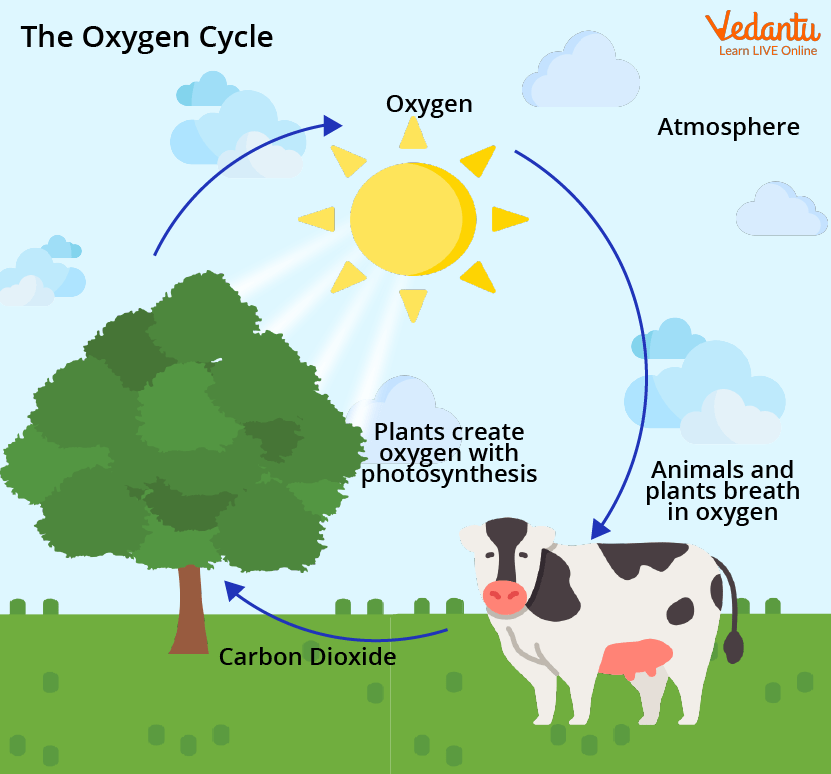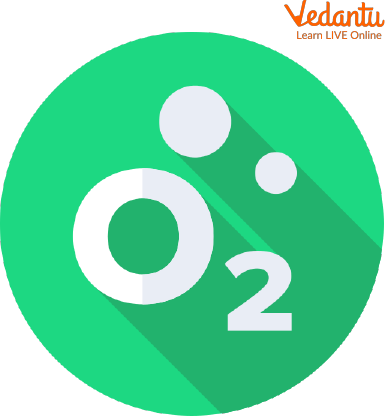




Process of Oxygen Cycle
We breathe in oxygen. Oxygen is an essential component of our life on Earth. Mostly oxygen is used for breathing. It is the most common component of the human body. It contributes to around 65% of the total human body weight. Most of this is in the form of water.
Here, we are going to learn about the oxygen cycle diagram, the simple oxygen cycle, and more about it. The oxygen cycle is the circulation of oxygen in the atmosphere. The oxygen cycle explains how free oxygen is available and how it is used by different organisms. In the Oxygen Cycle or Simple oxygen cycle, carbon plays an important role which is interlinked to oxygen.
Oxygen Cycle Diagram

The Oxygen Cycle
What is the Oxygen Cycle?
Oxygen is present in many forms in the atmosphere. Oxygen can be present in free form or dissolved in water. It is utilized by organisms in different ways. It is needed for the process of respiration in plants and animals. Animals inhale oxygen and exhale carbon dioxide in the air. While plants inhale carbon dioxide and exhale oxygen during the day time and at night plants take in oxygen and give out carbon dioxide.
Hence, the oxygen cycle transfers oxygen from one form to the other. In the oxygen cycle, there is the circulation of oxygen in nature. The oxygen cycle helps in the maintenance and balance of oxygen in nature. The atmosphere, lithosphere, and biosphere are involved in this cycle.

Molecular Formula of Oxygen
Oxygen Cycle Steps
Step 1: In the first step plants are included. Plants give out oxygen during the process of photosynthesis.
Step 2: Animals and other aerobic organisms take in oxygen to respire.
Step 3: These living beings release carbon dioxide into the atmosphere during the process of respiration. This carbon dioxide is again used by plants for photosynthesis to produce oxygen.
All these three steps complete the process of the oxygen cycle.
Oxygen Utilisation
Oxygen is utilised in the following ways.
Respiration: The process of inhalation of oxygen and exhalation of carbon dioxide is known as respiration. Oxygen is used by all organisms for respiration.
Decomposition: Decomposition in the oxygen cycle is an important process in which one compound is broken down into two or simpler compounds using oxidation.
Combustion: Combustion is the rapid oxidation of a material in oxygen. Combustion is exothermic, which means heat energy is released during the combustion reaction.
Rusting: Rusting is the oxidation of the metal or one metal and the reduction of another. The reaction usually occurs because one type of metal is exposed to air.
Importance of Oxygen Cycle
The oxygen cycle is an important process in Earth's atmosphere. It is a cycle of reactions involving the oxidation of carbon dioxide, the reduction of nitrous oxide, and the release of water vapour. This process effectively creates carbon dioxide and water vapour for plants to use as food for photosynthesis, which allows them to create their food sources. When this happens, it means that there is less carbon dioxide in the atmosphere and it will begin to significantly decrease radiation levels as well. Oxygen is necessary for the process of combustion. If oxygen will not be there we cannot burn fire. Without fire, we can not cook food. Hence the process of the oxygen cycle is very important. Oxygen cylinders are provided to patients who have breathing problems.
Significance of Oxygen Cycle
The significance of the oxygen cycle is as follows:
The importance of the oxygen cycle is that without it animals and plants would die because they need oxygen to live!
Without this cycle there would be no life on Earth - humans included!
It also benefits the environment, making it a huge benefit for us to contribute to this system.
The Oxygen cycle also helps in reducing air pollution, deforestation clearing land for farmland etc.
Summary
Now, we know What is Oxygen cycle. The oxygen cycle represents the circulation of oxygen from one organism to the other and its utilization in different forms. The oxygen cycle involves 3 steps, in which plants, animals, and other aerobic organisms. In breathing, decomposition, combustion, and rusting, oxygen are essential. Here, we have also discussed the process of the oxygen cycle and its importance. Oxygen is produced during the process of photosynthesis. Oxygen turns food into energy.
FAQs on What is Oxygen Cycle?
1. What is the oxygen cycle in simple terms?
The oxygen cycle is the natural process of how oxygen moves through the different parts of the Earth. It circulates through the atmosphere (air), the biosphere (living things like plants and animals), and the lithosphere (the Earth's crust). This cycle explains how oxygen is constantly being created and used.
2. What are the main steps in the oxygen cycle?
The oxygen cycle has two main steps that create a balance. First, plants produce oxygen and release it into the atmosphere during photosynthesis. Second, animals and humans breathe in this oxygen for respiration and use it to get energy from food. Other processes like decomposition and burning also use oxygen.
3. How do plants produce the oxygen we need to breathe?
Plants produce oxygen through a remarkable process called photosynthesis. They absorb sunlight, water, and carbon dioxide from the air to create their food. A very important byproduct of this process is oxygen, which plants release back into the atmosphere for other living things to use.
4. Why is the oxygen cycle so important for life on Earth?
The oxygen cycle is essential for survival. Most living organisms, including humans, need a steady supply of oxygen for respiration, which is the process of converting food into energy. Without this cycle continuously refreshing the oxygen in our atmosphere, most life would not be able to exist.
5. Where is most of the Earth's oxygen stored?
While we breathe oxygen from the air, the vast majority of it is not in the atmosphere. The largest reservoir of oxygen is locked away in the minerals that make up the Earth's crust and mantle. The atmosphere is actually one of the smallest reservoirs of oxygen on the planet.
6. What is the role of animals and humans in the oxygen cycle?
Animals and humans play the role of consumers in the oxygen cycle. We take in oxygen from the air when we breathe, and our bodies use it to get energy. In return, we exhale carbon dioxide, which is the gas that plants need for photosynthesis. This creates a balanced exchange between plants and animals.
7. Besides breathing, what are other ways oxygen gets used up?
Oxygen is used in several ways other than just respiration. The main ones include:
- Decomposition: When plants and animals die, the microbes that break them down consume oxygen.
- Combustion: Any kind of burning, such as a wildfire or a car engine, uses large amounts of oxygen.
- Oxidation: This is a chemical reaction that consumes oxygen, with a common example being the rusting of iron.
8. What would happen to life on Earth if photosynthesis suddenly stopped?
If photosynthesis stopped, it would be catastrophic for the planet. The main source of new oxygen would be gone. Over time, as living things continued to breathe and use oxygen, its levels in the atmosphere would drop significantly. Eventually, there wouldn't be enough oxygen to support most forms of life, including humans.
9. How are the oxygen and carbon cycles connected to each other?
The oxygen and carbon cycles are very closely linked through the processes of photosynthesis and respiration. Think of them as two sides of the same coin. Plants take in carbon dioxide (from the carbon cycle) and release oxygen (for the oxygen cycle). Animals and humans do the exact opposite, making the two cycles completely dependent on one another.









